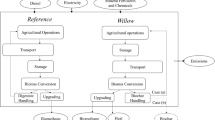Abstract
Goal and Scope
This study attempts to estimate the environmental performance of Polyhydroxyalkanoates (PHA), from agricultural production through the PHA fermentation and recovery process – “cradle to gate”. Two types of PHA production systems are investigated: corn grain based PHA and corn grain and corn stover based PHA.
Methods
Corn cultivation data are taken from 14 counties in the Corn Belt states of the United States – Illinois, Indiana, Iowa, Michigan, Minnesota, Ohio, and Wisconsin. The environmental burdens associated with the corn wet milling process, in which dextrose, corn oil, corn gluten meal and corn gluten feed are produced, are allocated to dextrose and its coproducts by the system expansion approach. Greenhouse gases include carbon taken up by soil, nitrous oxide (N2O) released from soil during corn cultivation, carbon contents in biobased products as well as carbon dioxide, methane and nitrous oxide released from industrial processing. The soil carbon and nitrogen dynamics in corn cultivation are predicted by an agro–ecosystem model, the DAYCENT model. The environmental performance of the PHA production system is compared to that of a conventional polymer fulfilling an equivalent function. The environmental performance is addressed as nonrenewable energy and selected potential environmental impacts including global warming, photochemical smog, acidification, and eutrophication. The characterization factors are adapted from the TRACI model (Tools for the Reduction and Assessment of Chemical and Other Environmental Impacts) developed by the United States Environmental Protection Agency.
Results and Discussion
Global warming associated with corn grain based PHA is 1.6–4.1 kg-CO2 eq. kg–1. The primary contributing process to most environmental impacts except for photochemical smog and eutrophication is the PHA fermentation and recovery process. For photochemical smog and eutrophication, the primary contributing process is corn cultivation due to nitrogen related burdens from soil. The trend of PHA fermentation development shows that the PHA fermentation technology is still immature and continues to improve, thereby also decreasing the environmental impacts. PHA produced in an integrated system, in which corn stover is harvested and used as raw material for PHA along with corn grain, offers global warming credits (negative greenhouse gas emissions), ranging from –0.28 to –1.9 kg-CO2 eq. kg–1, depending on the PHA fermentation technologies employed and significantly reduces the environmental impacts compared to corn based PHA. The significant reductions from the integrated system are due to 1) less environmental impacts in corn cultivation and wet milling, and 2) exporting surplus energy from lignin–rich residues in corn stover process.
Conclusions and Outlook
Under the current PHA fermentation technology, corn grain based PHA does not provide an environmental advantage over polystyrene. Corn grain based PHA produced by the near future PHA fermentation technology would be more favorable than polystyrene in terms of nonrenewable energy and global warming due to improvement in the PHA fermentation and recovery process. However, corn grain based PHA produced in even the near future technology does not provide better profiles for other environmental impacts (i.e., photochemical smog, acidification and eutrophication) than polystyrene. One of the primary reasons for high impacts of PHA in photochemical smog, acidification and eutrophication is the environmental burdens associated with corn cultivation. Thus other approaches to reduce these burdens in the agricultural process (e.g., use of buffer strips, etc.) are necessary to achieve better profiles for photochemical smog, acidification and eutrophication associated with corn cultivation. PHA produced in the integrated system is more favorable than polystyrene in terms of most environmental impacts considered here except for eutrophication.
Similar content being viewed by others
Author information
Authors and Affiliations
Corresponding authors
Rights and permissions
About this article
Cite this article
Kim, S., Dale, B. Life Cycle Assessment Study of Biopolymers (Polyhydroxyalkanoates) - Derived from No-Tilled Corn (11 pp). Int J Life Cycle Assessment 10, 200–210 (2005). https://doi.org/10.1065/lca2004.08.171
Received:
Accepted:
Published:
Issue Date:
DOI: https://doi.org/10.1065/lca2004.08.171




